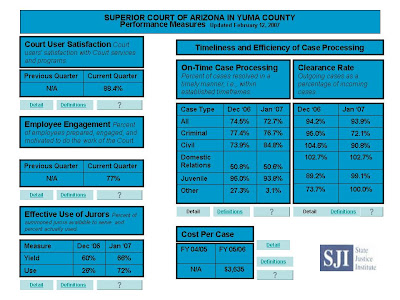The Yuma Superior Court Launches Its Performance Dashboard

On Thursday this week, the Superior Court in Yuma County, Arizona, launched the first version of its performance dashboard. In an email introducing it to all court and county employees, Court Administrator Margaret Guidero, who leads the CourTools Design Team developing the court’s performance measurement system, wrote that “together, the six measures of performance will help us to address the question ‘How are we doing?’ and improve accordingly.”
Guidero explained that the current performance dashboard is a static version that soon will be Web-based and dynamic. “In the future, you will be able to view the Court’s core performance measures at a glance and then move swiftly through successive layers of more detailed information,” she wrote. Currently, users have to open six PDF files attached to the static version of the dashboard for more detailed information about the corresponding performance measures. For general definitions of the six measures, as well as four other measures yet-to-be developed, the dashboard points to a link to the CourTools, a model for court performance measurement developed by the National Center for State Courts (NCSC). Finally, for comments and questions about specific measures, she listed the names, telephone numbers and email addresses of six court managers who are the designated owners of the performance measures.
Responsive to Local and State Forces
Guidero explained that the current performance dashboard is a static version that soon will be Web-based and dynamic. “In the future, you will be able to view the Court’s core performance measures at a glance and then move swiftly through successive layers of more detailed information,” she wrote. Currently, users have to open six PDF files attached to the static version of the dashboard for more detailed information about the corresponding performance measures. For general definitions of the six measures, as well as four other measures yet-to-be developed, the dashboard points to a link to the CourTools, a model for court performance measurement developed by the National Center for State Courts (NCSC). Finally, for comments and questions about specific measures, she listed the names, telephone numbers and email addresses of six court managers who are the designated owners of the performance measures.
Responsive to Local and State Forces
The Superior Court in Yuma is a rural, small to medium, general jurisdiction court in southwest Arizona. The Court’s performance measurement and management initiative is supported by grants from the State Justice Institute and the Arizona Administrative Office of the Courts. (Full disclosure: As NCSC’s Of Counsel in Performance Measurement, I assist the Yuma Superior Court and its CourTools Design Team with its performance measurement and management initiative.)
Several forces have moved the court toward performance measurement. Among them, at the local level, the Yuma County Administrator’s Office was pressuring the court to develop and report performance measures that support the county’s strategic planning and budgeting efforts. At the state level, the Arizona Supreme Court issued its Strategic Agenda for Arizona’s Courts 2005-2010. It includes five strategic goals and the initiatives adopted by the Supreme Court to attain those goals, and directs local courts to “review the ten core CourTools developed by the National Center for State Courts and implement those measures determined to be beneficial.”
Can Small Courts Build Performance Dashboards?
The short answer is yes they can. My colleagues and I have urged courts and court systems to design, develop and implement automated performance measurement systems supported by multiple interlocking layers of technology and business architecture that translate mission and strategies into clear performance metrics. Further, we’ve recommended that the performance information be communicated quickly and concisely in the form of performance dashboards, scorecards or other computer-screen displays.
But what about courts, especially small courts, that do not have the money to buy, or the technology resources to build, sophisticated computer-based performance display systems? Are such systems a necessary requirement for success?
No, as the Yuma Superior Court demonstrated this week. An effective presentation of a set of performance measures is one: (a) that users can readily access, (b) that is easily read and understood, (c) that is organized for easy navigation among core and subordinate measures, and (d) one that provides a “line of sight” which conveys to everyone what the drivers of success are and provides them with the concrete knowledge of how they contribute to that success. Yuma’s static version of its performance dashboard meets these criteria.
Few courts today operate without spreadsheet programs like Excel to organize, analyze and present data for budget and case processing reports. Computer software that sets up a simple, easy-to-read and easy-to-update system to track performance is merely an extension of such spreadsheet programs. Step 6 of building an effective court performance system (CPMS) should not be read as a necessary requirement to buy or to develop sophisticated performance management computer software but, instead, simply as a strong recommendation to look at increasingly available technology to reach farther, faster, wider and deeper than paper reports can.
For the latest posts and archives of Made2Measure click here.
© Copyright CourtMetrics 2007. All rights reserved
© Copyright CourtMetrics 2007. All rights reserved
Comments
Post a Comment